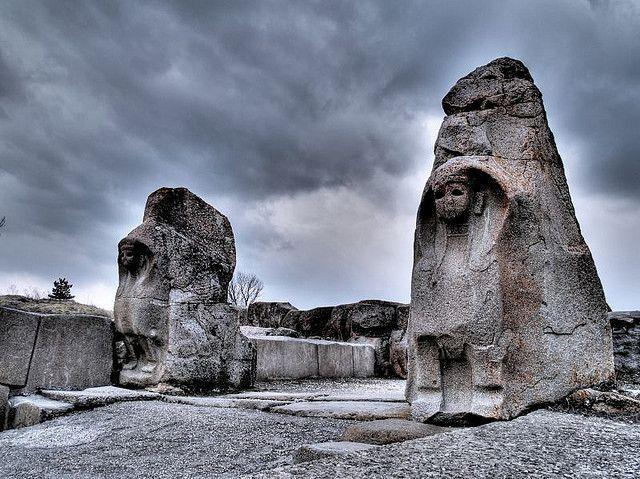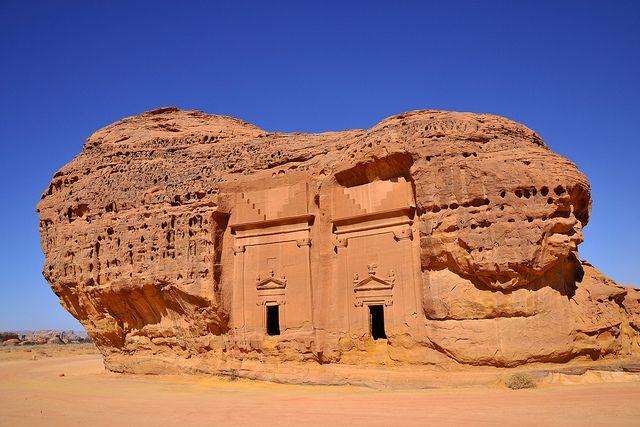 (Image: Sr. Samolo, cc-nc-nd-4.0)
(Image: Sr. Samolo, cc-nc-nd-4.0)
The Middle East is where the Western world began. Judaism, Christianity, Islam, writing and number systems all first reared their heads on the fertile plains around Ancient Mesopotamia. For centuries, the region was known as the “cradle of civilisation”. Yet huge swathes of this historically-important world were lost for centuries. Entire regions, cities and cultures have winked out of history, leaving only the faintest traces.
Ai (Canaan)
 (Image: Gustav Dore, public domain)
(Image: Gustav Dore, public domain)
Seeped in blood and overflowing with violence, the Biblical Book of Joshua is an account of the wars waged by the Israelites through Ancient Canaan. Famously, this includes the siege of Jericho. But there’s one other city the author specifically mentions by name: the long-lost royal city of Ai.
Supposedly a thriving religious centre, Ai is recorded as the second Canaanite city to fall under Joshua’s sword. The Biblical narrative makes it emphatically clear that the place was burned to the ground and all its inhabitants slaughtered. However, modern attempts to find the ‘real’ Ai have come up lacking. The most-likely candidate – a site known as Et-Tell – shows no sign of a violent end, and is generally thought to have been abandoned hundreds of years before the time of Joshua.
 (Image: Morgan Bible, public domain)
(Image: Morgan Bible, public domain)
It’s currently thought that the Biblical account is a fictional take on the causes of the Et-Tell ruins (Ai means ‘ruin’ in Hebrew). Unless a more-plausible candidate is unearthed, it may be that Biblical Ai never really existed in the first place.
Ur (Ancient Sumer)
 (Image: Tla2006, public domain)
(Image: Tla2006, public domain)
The story of Ur is one of slow decline and a protracted death. At its height, the city was a vibrant trade port, a place of learning and scholarship all watched over by a gigantic ziggurat, towering into the heavens. Ships from as far away as India docked at its port. Biblical Abraham was said to have been born there. It was one of the regional giants for over 2,000 years. And then, around 450BC, it simply vanished.
 (Image: M.Lubinski, cc-4.0)
(Image: M.Lubinski, cc-4.0)
Rather than invasion, Ur had fallen victim to the shifting nature of the Euphrates River. Perched right on the water’s edge at its foundation in the 4th millennium BC, by the time it vanished, Ur was lost several miles inland. Without the port to keep the economy alive, the inhabitants moved out and Ur was left to the mercy of the sands. Completely lost for two and a half millennium, it was only properly rediscovered after World War One.
Akkad (Mesopotamia)
 (Image: Middle East Topographic Map, cc-sa-3.0)
(Image: Middle East Topographic Map, cc-sa-3.0)
The Akkadian Empire was history’s first great empire. Stretching across Ancient Mesopotamia and the Levant and extending into Iran, it was the most powerful economic and political force on Earth for nearly 200 years. Under Akkadian rule, literature and art flourished. Science rose to prominence. Yet the location of its capital has somehow been lost completely.
 (Image: Louvre Museum, public domain)
(Image: Louvre Museum, public domain)
Known as Akkad, the hub of the empire was a city state that became a superpower in an incredibly short period of time. A political and cultural powerhouse, it was like modern London, New York and Hong Kong all rolled into one. It’s mentioned in the book of Genesis, in hundreds of ancient cuneiform tablets and in several old inscriptions, and was for 200 years probably the most important place in existence. But there our knowledge ends. Over the years scholars have tried to locate it anywhere from along the Euphrates River, to under modern Baghdad, to somewhere on the Tigris. Yet its location eludes us. Short of a miracle, Akkad may turn out to be the most-interesting site our archaeologists will never study.
Antioch (Ancient Syria)
 (Image: Wmpearl, public domain)
(Image: Wmpearl, public domain)
Founded in 300BC by a former general of Alexander the Great, Antioch was one of the ancient world’s great centres. The capital of the Seleucid Kingdom until 64AD, it was later one of the Roman Empire’s principle outposts and the place where St Paul basically founded modern Christianity. At its height, the city was home to half a million people – making it larger than modern-day Atlanta or Miami. Unlike some on this list, we also know where its ruins lie: just outside Antakya in modern Turkey. But good luck trying to find its most-famous landmarks.
 (Image: L.Gallait, public domain)
(Image: L.Gallait, public domain)
Thanks to an unfortunate position on the Orontes River, it’s thought that most of Antioch’s grand buildings now lie beneath a thick layer of mud. The Imperial Palace and Constantine’s Great Church have never been located, and urban expansion in north Antakya has led to acres of smaller ruins being bulldozed over. At current rates, it won’t be long before Antioch truly is lost forever.
Hattusa (Anatolia)
The 12th Century was a strange time in Anatolia. At the same time as the Hittite Empire was falling into degradation and decline, its capital Hattusa was undergoing spectacular expansion. New temples were being thrown up, the city’s population was doubling and it was taking on the appearance of an ancient Dubai – the ultimate boomtown. Yet within less than half a century, Hattusa would be abandoned, ransacked, burnt to the ground and lost for nearly 2,000 years.
 (Image: Mario Columba, cc-nc-sa-4.0)
(Image: Mario Columba, cc-nc-sa-4.0)
Why this happened is still a mystery. Although Hattusa was rediscovered in 1834, its long period of silence created many questions, most of which we’ll likely never answer. Prior to the city’s abandonment, all of Hattusa’s records were apparently removed to an unknown location, leaving a great big gap in the story of the place. Although now fully uncovered and listed as a UNESCO World Heritage site, this lack of history means vital chunks of Hattusa’s past continue to feel lost, even as archaeologists comb the ruins for clues.
Nineveh (Mesopotamia)
 (Image: Mark Murphy, cc-sa-3.0)
(Image: Mark Murphy, cc-sa-3.0)
If you could travel back in time to 7th Century BC Nineveh, you’d find yourself in one of the greatest cities in history. Blasted by the burning Middle Eastern sun and nestled on the banks of the Tigris River, Nineveh was opulence on a previously unimaginable scale. Fifteen elaborate gates opened up on streets criss-crossed by Amsterdam-style canals. Cool squares provided shade to hide from the desert heat. A great palace – unlike anything ever seen before – towered over everything, while some distance away sat the library; stuffed with all the learning of an empire. Nineveh was, in short, magnificent. Yet for over two thousand years we managed to misplace it entirely.
In 612 BC, Nineveh was sacked so completely that even its foundations were razed. Following the fire, it vanished from history – its memory only preserved in nightmarish Biblical passages telling of God’s divine wrath. It wasn’t until the 1840’s that the site of Nineveh was finally recovered, rescuing the Neo-Assyrian capital from historical oblivion.
Samaria (Ancient Palestine)
 (Image: Golf Bravo, public domain)
(Image: Golf Bravo, public domain)
The second capital of the ancient kingdom of Israel, Samaria perished first in fire and then beneath the muck and dirt of history. Constructed by Omri around 870BC, it perched atop a flat-topped hill in what are now the modern Palestinian Territories. The history of the city reads like a series of calamities unfolding with clockwork regularity. Within a century of being constructed, the city had been flattened and occupied by Assyrian invaders. A couple of hundred years later it was flattened once again: this time by a Jewish army.
Under the Romans, Samaria was torn down, rebuilt and reconstructed all over again. In the midst of all this building and demolition, the original city disappeared from history – as completely as the original settlements of New York would vanish 1,500 years later. It wasn’t until 1910 that excavations dragged up the first traces of the once-proud Israelite capital.
Persepolis (Persia)
 (Image: via Wikimedia, cc-sa-3.0)
(Image: via Wikimedia, cc-sa-3.0)
Although it lasted a mere 200 years, memories of the impossible city of Persepolis have stayed with humanity for millennia. Built on an artificially-levelled mountain top, the city was almost dizzying in its opulence. Great palaces sat at the top of sweeping staircases, their doors decked in gold and precious metals. Pillars leapt up into the firmament and elaborate statues watched over the coming and going of the citizens. Then in 330BC, Alexander the Great found this hidden gem and put it to the torch.
 (Image: Pourhassan, Alireza, cc-sa-3.0)
(Image: Pourhassan, Alireza, cc-sa-3.0)
The resulting fire was so intense that almost nothing was left standing. With the destruction being so total, nothing like reconstruction was ever attempted, and the name of this ruined city was lost to time. It wasn’t until the 17th century that people finally equated these charred pillars with the long-lost Persepolis – some 2,000 years after its first stone was originally laid.
Mada’in Saleh (Arabia)
If you’ve ever seen photos of Petra, you’ll know what Mada’in Saleh looks like. An important, stone-carved city of the Nabataean Kingdom, its history likewise mirrors that of its more-famous cousin.
Founded in the first century on top of an older settlement, Mada’in Saleh had only a few brief years as a centre of Nabataean culture before the Romans took control. Following the collapse of the Roman Empire, the city simply slipped away into history. Its location and existence were mostly forgotten; few people lingered by or settled in its walls and gradually the area fell into decline. Like Petra, it remained completely unknown in the Western world until comparatively recently, while even the Islamic world only recorded it as the remains of a city Allah had been forced to destroy.
It wasn’t until a railway for pilgrims was built through the site at the start of the 20th Century that the world recognized Mada’in Saleh for the gem it was. Currently the site sits on UNESCO’s World Heritage list: the first place in Saudi Arabia to earn that honour.
Kish (Sumer)
 (Image: via Wikipedia, public domain)
(Image: via Wikipedia, public domain)
In Sumerian lore, the ancient city of Kish held a very special place. According to their civilisation’s ‘list of kings’, Kish was the first city to be occupied following the Deluge. That’s the same Deluge that Noah rode out in the Bible, the same Deluge recorded in countless ancient civilisations. For the Sumerians, the globe-destroying flood was as important as the story of Noah is to Christians, giving Kish huge symbolic importance.
Although little is known about the actual layout of the city, we do know it was considered a desirable place to rule, right up through to the Neo-Babylonian period. Like so many on this list, it was eventually abandoned and all-but forgotten until the 20th Century. Currently a number of excavations have been made, although huge gaps continue to remain in our knowledge.







